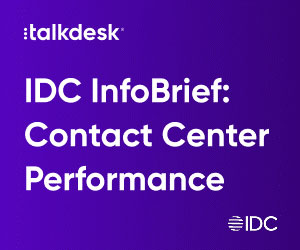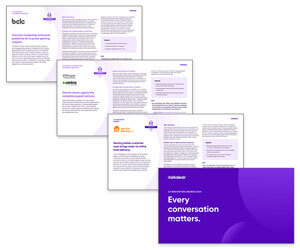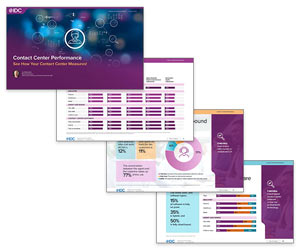Pedro Andrade at Talkdesk explores how agentic AI is redefining voice conversations in the contact centre – moving beyond static scripts to create real-time, human-like interactions that are intelligent, adaptable, and emotionally aware.
We blink, and another breakthrough in AI transforms what seemed impossible just yesterday.
We’ve created machines that write poetry, compose music, and mimic human speech-yet when it comes to real-time understanding and decision-making in voice conversations, AI has remained surprisingly limited, especially for customer interactions.
The customer experience space is shifting to digital reality, but voice interactions are still the most used communication channel.
An IDC InfoBrief: contact centre Performance survey reports a volume of 2.74 billion inbound and outbound calls, making clear that voice still plays a critical role that can’t be overlooked.
Providing exceptional service to those calling in is just as important as delivering quality service through digital channels. The problem is that with calls, the difference between a seamless interaction and a frustrating one is measured in milliseconds.
While digital text tolerates brief delays, the immediacy of voice demands immediate processing to mimic human conversations, where communication flows seamlessly without noticeable pauses.
Even small delays can negatively impact the user experience, creating a sense of disconnection and disrupting the natural flow of conversation.
For example, AI must pick up on pauses or slight changes in tone that indicate hesitation, excitement, or doubt and take immediate action to adapt.
Unlike chat and text conversations, voice conversations don’t follow a fixed script. We interrupt, change direction mid-sentence, and weave in “ums” and “uhs”-a significant challenge to traditional AI.
It’s the ability to understand and respond to a variety of inputs very quickly that turns a rigid, robotic interaction into a smooth, human-like conversation.
The unpredictability of natural dialogue requires more than word recognition; it needs to understand the intent behind them, even when that intent shifts abruptly.
Moving From Static Scripts to Agentic AI Conversations
Unlike AI agents, traditional voice bots follow a static script, predefined intents, and rigid decision trees.
They handle the simple, predictable issues but stumble on the unexpected because they miss the natural flow of conversation, the background noise, the general stress that comes with needing urgent help, and the slight variations in language.
They’re unable to process natural speech or respond empathetically in high-pressure situations, and this lack of flexibility leads to real frustration and wasted time.
AI Agents for voice, on the other hand, doesn’t just recognize speech – it actively listens, understands, decides, and adapts in real time. It can handle interruptions, contextual changes, and emotional cues making voice AI feel truly human-like, natural, and responsive for the first time.
For example, someone’s flight was canceled on their way to the airport. They call the airline, and the initial inquiry might be simple: “My flight’s been canceled.” However, the conversation can change suddenly.
A simple “cancel ticket” request might shift into a need to “rebook the ticket” for the next available flight, or maybe the traveler changes their mind and decides to “buy a new ticket” altogether.
AI agents for voice conversations can recognize the subtle shifts in language that indicate a change in intent and seamlessly handle all the available options for the traveler’s potential decision paths.
In addition to listing the choices, they understand the implications of each. If the “cancel ticket” request evolves into a need to “rebook the ticket” for the next available flight, agentic AI weighs factors like available seating, potential layovers, and arrival times, to give the traveler the best rebooking options.
If they decide to “buy a new ticket”, it seamlessly navigates the new booking process, considering seat preferences, loyalty programs, and payment options available in an eventual policy documentation previously ingested and integrated into the AI agent pool of tools to access, and drive decisions.
level of adaptability goes beyond simple command execution to engage in genuine problem-solving. It offers a personalized and responsive experience to empower the traveler to make informed decisions, even during unexpected disruptions.
The Human Touch of AI Agents For Voice Conversations
Emotion and tone are crucial for authentic and engaging conversations. Agentic AI for voice calls understands what is being said, how it’s being said, and the emotions driving the speech to deliver a human-like experience.
One of the biggest challenges in achieving this human touch is real-time sentiment analysis. AI agents must be able to pick up on subtle emotional cues, such as frustration, excitement, or confusion, and adjust the tone and responses accordingly.
This dynamic tone adjustment requires more than just processing language – it requires an interpretation of the emotional context of the conversation.
Whether it’s providing reassurance during a stressful situation or matching the enthusiasm of a happy customer, this real-time emotional intelligence is what separates generative AI from traditional voice technology.
Beyond emotional-responsive voice, shaping AI-driven voice conversations by specifying how the voice should sound is a game-changer for high-quality AI-powered automation.
By controlling the tone and speaking style – such as instructing a voice agent to sound empathetic, authoritative, or conversational – businesses can create more engaging and context-aware interactions.
Additionally, the ability to prompt for natural speech patterns, including hesitations like “ums” and “uhs”, makes conversations feel even more lifelike and human.
This flexibility is crucial for delivering superior customer experiences, ensuring that automated voice agents feel natural and aligned with the brand’s identity.
In use cases like customer support or sales, the ability to fine-tune voice modulation and inject natural speech elements drives user trust, improves comprehension, and makes AI interactions more effective and relatable.
Multi-language support and the ability to handle code-switching, where speakers switch between languages or dialects within the same conversation, add another layer of complexity.
In addition to detecting the language being used in real time, AI agents for voice calls also transition smoothly between languages without interrupting the flow. This seamless shift is crucial in maintaining a natural conversation, especially for users in multilingual environments.
Secure and Compliant Agentic AI
While the user experience is key for voice AI, the technical infrastructure behind it is equally critical. The power of agentic voice AI lies in the seamless integration with backend systems like customer relationship management (CRM) and databases, which allow it to access and process real-time data.
Without this smooth integration, it wouldn’t be possible to provide timely, personalized responses and calls would feel disjointed.
To create a truly intelligent agent, voice AI must be able to instantly pull from diverse data sources, synthesizing information from multiple touchpoints in a way that feels coherent and human-like.
Another essential consideration is security. In industries like finance and healthcare, where sensitive information is exchanged, voice AI must adhere to the highest standards of security and compliance regulations, such as GDPR or HIPAA. Any breach of trust in these sectors has severe legal and reputation consequences.
This blog post has been re-published by kind permission of Talkdesk – View the Original Article
For more information about Talkdesk - visit the Talkdesk Website
Call Centre Helper is not responsible for the content of these guest blog posts. The opinions expressed in this article are those of the author, and do not necessarily reflect those of Call Centre Helper.
Author: Talkdesk
Reviewed by: Megan Jones
Published On: 29th Apr 2025
Read more about - Guest Blogs, Talkdesk






 Talkdesk is a global customer experience leader for customer-obsessed companies. Our contact center solution provides a better way for businesses and customers to engage with one another.
Talkdesk is a global customer experience leader for customer-obsessed companies. Our contact center solution provides a better way for businesses and customers to engage with one another. 
































